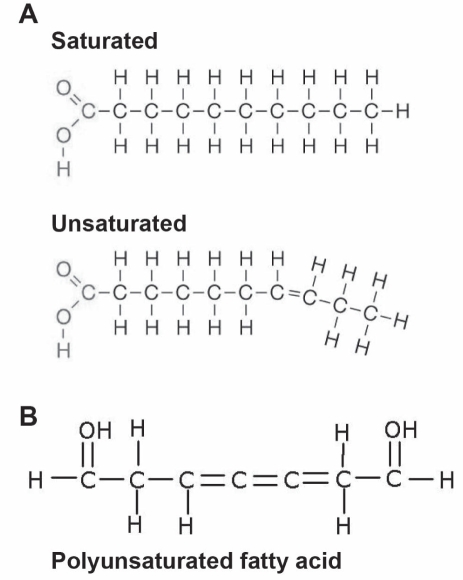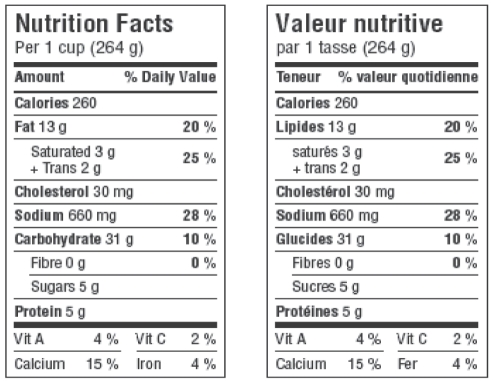Abstract
Hydrogenation of fat products is used in the food industry to extend their shelf life. Trans fats are the result of partial hydrogenation of unsaturated fat. Trans fats increase low-density lipoprotein cholesterol and decrease high-density lipoprotein cholesterol, thus increasing the risk of cardiovascular disease. Canadians have one of the highest dietary intake of trans fat in the world. Health Canada has made recommendations to decrease the trans fat intake of Canadians. Physicians should be able to provide their patients with information on trans fats and their deleterious effects on health.
Keywords: Cardiovascular disease, Cholesterol, Hydrogenation, Saturated fat, Trans fat, Unsaturated fat
Abstract
L’industrie alimentaire recourt à l’hydrogénation des produits gras pour en allonger la durée de conservation. Les gras trans résultent de l’hydrogénation partielle des gras insaturés. Ils accroissent le cholestérol à lipoprotéines de basse densité et réduisent le cholestérol à lipoprotéines de haute densité, augmentant ainsi le risque de maladie cardiovasculaire. Les Canadiens présentent l’une des consommations de gras trans alimentaires les plus élevées du monde. Santé Canada a fait des recommandations en vue de réduire la consommation de gras trans des Canadiens. Les médecins devraient être en mesure de fournir à leurs patients de l’information sur les gras trans et sur leurs effets néfastes sur la santé.
Français en page 376
Parents want what is best for their children. They want to be able to make the right food choices not only to ensure that their children grow well but also to prevent future illnesses such as coronary artery disease.
Recently, the issue of trans fats has received a lot of attention. There is a large body of literature (1) available associating the consumption of trans fats with deleterious effects on health. The physician is in a position to give advice to parents on the implication of trans fats on children’s health. The present practice point provides physicians with information on trans fats.
Fats come in different forms (Figure 1). A triglyceride molecule consists of a glycerol backbone, to which three fatty acids are attached. These fatty acids are made up of chains of different numbers of carbon atoms attached together by simple or double bonds.
Figure 1).
Chemical composition of the different types of fat. A Saturated and unsaturated fatty acid. B Polyunsaturated fatty acid. Reproduced from references 8 and 9
Saturated fats are molecules of fat in which the double bonds between carbon atoms have been replaced by hydrogen atoms. In other words, each carbon atom has four other atoms attached to it.
Unsaturated fats are molecules of fat containing one or more double bonds between two atoms of carbon at specific positions in the chain. Unsaturated fats come in a ‘cis’ form and a ‘trans’ form, according to the arrangement of the carbon chains across one or more double bonds.
Trans fats are unsaturated fats with trans double bonds instead of cis bonds. The type of bond affects the shape of the fatty acid chain. A trans bond creates a straight chain, whereas a cis bond results in a chain that is bent. Trans fats may be monounsaturated or polyunsaturated.
The production of trans fats is a result of partial hydrogenation. The process of hydrogenation consists of chemically adding atoms of hydrogen to cis unsaturated fat, eliminating the double bonds between carbon atoms and making them saturated. Hydrogenation is used by the food industry to extend shelf life by making fats less prone to rancidity – a phenomenon by which free radicals attack the double bond between carbon atoms. It also increases the fat’s melting point, making the product more suitable for frying. However, in the process of hydrogenation, some of the cis bonds in fatty acids are transformed to trans bonds, resulting in trans fatty acids rather than in saturated fatty acids (2).
Unfortunately, trans fats have deleterious effects on human health. They not only increase low-density lipoprotein cholesterol but also decrease high-density lipoprotein cholesterol, thus increasing the risk of cardiovascular disease. Trans fats provide no benefits to human health and are not essential. Therefore, there is no such thing as a safe level of dietary trans fat.
Trans fats naturally occur in small amounts in the fat of certain foods such as dairy and meat. They are also present in breastmilk in concentrations directly dependent on the mothers’ dietary intake of trans fats. Trans fats originating from processed foods are, by far, the largest dietary source of trans fats consumed.
According to a survey performed in 1995, Canadians had one of the highest dietary intakes of trans fats in the world at 8.4 g/day. This was primarily due to the widespread use of hydrogenated oils in prepackaged foods and for cooking in restaurants, particularly fast food restaurants.
In 2002, Health Canada introduced mandatory nutrition labelling of most prepackaged foods, as well as new and revised requirements for nutrient content claims. The Nutrition Facts table requires the declaration of the content of energy and 13 nutrients including trans fats (Figure 2). It is important to remember that to be labelled ‘trans fat free’, a food item must contain less than 0.2 g of trans fat per reference amount and per serving, and must be ‘low in saturated fat’ (less than 2 g of saturated fat and trans fat combined per reference amount and per serving). Nutrition labelling together with increased consumer awareness of trans fat have acted as a driving force, resulting in the reduction or elimination of trans fats in many foods. Since 2006, there have also been voluntary guidelines for providing nutrition information on food sold in restaurants; many major restaurant chains have committed to implementing voluntary guidelines.
Figure 2).
Nutrition Facts table format. Reproduced from reference 10
As a result of these measures, intakes of trans fats decreased to 4.9 g/day in 2005. However, this level of intake is still very high and largely above the WHO’s recommended intake of less than 1% of total daily caloric intake. Further action is still required.
The Trans Fat Task Force report (3) released in 2006 recommended that the total amount of trans fats in food should be limited through regulation, and that information on healthier alternatives should be provided to the food industry. The proposed limits would decrease trans fat intake by approximately 55%, which would significantly improve the cardiovascular health of Canadians.
In 2007, the Minister of Health announced that Health Canada would adopt the Trans Fat Task Force’s recommended limits for trans fats in foods. Those recommendations were to limit the trans fat content of vegetable oils and soft, spreadable margarines to 2% of the total fat content, and to limit the trans fat content for all other foods to 5% of the total fat content, including ingredients sold to restaurants. Health Canada also announced that it would develop regulations to enforce the limits if significant progress had not been made after a two-year voluntary reduction period.
Health Canada, as part of the Trans Fat Monitoring Program, has been analyzing selected foods that were significant sources of trans fats (4). Results of the analysis of prepackaged foods, and foods from restaurant and fast food chains, were released in December 2007 (5), in July 2008 (6) and in February 2009 (7). Results from all three sets of data demonstrate progress in reduction of trans fats in different food categories. In many cases, the reduction was achieved by finding healthier alternatives and not by increasing the saturated fat content.
Canadians are more aware of the deleterious effects of trans fats on their health. With the information that is now available to them, they can make better choices for themselves and their children. Physicians should be aware of the negative impact that trans fats can have on their patients’ future health and should be able to provide parents with adequate information.
We suggest that physicians provide information on trans fats when giving nutritional guidance to parents and patients.
Acknowledgments
The author thanks Sara Krenosky (Health Canada) for her assistance with the present practice point.
Footnotes
NUTRITION AND GASTROENTEROLOGY COMMITTEE
Members: Drs Jeff Critch, Janeway Children’s Health and Rehabilitation Centre, St John’s, Newfoundland and Labrador; Manjula Gowrishankar, Walter C MacKenzie Health Sciences Centre, Edmonton, Alberta; Valérie Marchand, Sainte-Justine University Hospital Center, Montreal, Quebec (Chair); Sharon L Unger, Mount Sinai Hospital, Toronto, Ontario; Robin C Williams, Niagara Region Public Health Unit, Thorold, Ontario (Board Representative)
Liaisons: Ms Genevieve Courant, VON Community Wellness Clinic, Sudbury, Ontario (Breastfeeding Committee for Canada); Dr George Davidson, BC Children’s Hospital, Vancouver, British Columbia (Human Milk Banking Association); Ms Tanis Fenton, Foothills Hospital, Calgary, Alberta (Dietitians of Canada); Dr Frank Greer, Madison, Wisconsin, USA (American Academy of Pediatrics, Committee on Nutrition); Ms Jennifer McCrea, Ottawa, Ontario (Office of Nutrition Policy and Promotion, Health Canada); Ms Christina Zehaluk, Ottawa, Ontario (Bureau of Nutritional Sciences, Health Canada)
Consultant: Dr Jae Hong Kim, UCSD Medical Center, San Diego, California, USA
Principal author: Dr Valérie Marchand, Sainte-Justine University Hospital Center, Montreal, Quebec
The recommendations in this statement do not indicate an exclusive course of treatment or procedure to be followed. Variations, taking into account individual circumstances, may be appropriate. All Canadian Paediatric Society position statements are reviewed, revised or retired as needed on a regular basis. Please consult the “Position Statements” section of the CPS website (www.cps.ca/english/publications/statementsindex.htm) for the most current version.
REFERENCES
- 1.Health Canada It’s Your Health: Trans Fats<www.hc-sc.gc.ca/hl-vs/iyh-vsv/food-aliment/trans-eng.php> (Accessed on April 27, 2010).
- 2.Ratnayake WMN, Chen ZY. Trans fatty acids in Canadian breast milk and diet. In: Przybylski R, McDonald BE, editors. Development and Processing of Vegetable Oils for Human Nutrition. Champaign: The American Oil Chemists Society; 1995. pp. 20–35. [Google Scholar]
- 3.Health Canada Task Force on Trans Fat. TRANSforming the Food Supply<www.hc-sc.gc.ca/fn-an/nutrition/gras-trans-fats/tf-ge/tf-gt_rep-rap-eng.php> (Accessed on April 27, 2010).
- 4.Health Canada Trans Fat Monitoring Program<www.hc-sc.gc.ca/fn-an/nutrition/gras-trans-fats/tfa-age_tc-tm-eng.php> (Accessed on April 27, 2010).
- 5.Health Canada Trans Fat Monitoring Program. First Set of Monitoring Data<www.hc-sc.gc.ca/fn-an/nutrition/gras-trans-fats/tfa-age_first-data_prem-donn-eng.php#highlights> (Accessed on April 27, 2010).
- 6.Health Canada Trans Fat Monitoring Program. Second Set of Monitoring Data<www.hc-sc.gc.ca/fn-an/nutrition/gras-trans-fats/tfa-age_sec-data_deux-donn-eng.php#high> (Accessed on April 27, 2010).
- 7.Health Canada Trans Fat Monitoring Program. Third Set of Monitoring Data. <www.hc-sc.gc.ca/fn-an/nutrition/gras-trans-fats/tfa-age_tc-tm-intro-eng.php#highlight> (Accessed on April 27, 2010).
- 8.Saturated and unsaturated fatty acid<www.electrical-res.com/EX/10-18-08/fat_f2.jpg> (Accessed on June 29, 2010).
- 9.Polyunsaturated fatty acid<www.natural-health-information-centre.com/image-files/unsaturated-fat.jpg> (Accessed on June 29, 2010).
- 10.Nutrition Facts table format<www.hc-sc.gc.ca/fn-an/alt_formats/hpfb-dgpsa/pdf/label-etiquet/compend_nut_fact-repertoire_etiquetage_nut-eng.pdf> (Accessed on June 29, 2010).




